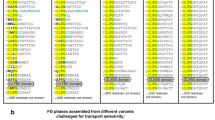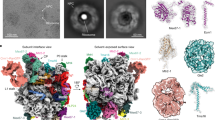Abstract
The nuclear envelope defines a compartment boundary which is penetrated by pores that mediate a remarkable transport process. Precursor RNAs are retained in the nucleus, while processed messenger RNA1, transfer RNA2 and ribosomal subunits3 are transported to the cytoplasm. Proteins destined for the nucleus become localized soon after synthesis and again following mitosis, while cytoplasmic proteins are excluded4. The process is highly specific: a single base change in vertebrate initiator tRNAMet (tRNAimet) reduces the rate of export 20-fold5; a point mutation within the simian virus 40 (SV40) large-T antigen, converting Lys 128 to Thr (ref. 6) or Asn (ref. 7), prevents import. Lys 128 lies within a short ‘signal’ sequence which, when fused to large non-nuclear proteins, causes their accumulation in nuclei6–8. Regions of other eukaryotic proteins also seem to contain nuclear localization signals, although a single consensus sequence has not emerged9–13. We report here that a synthetic peptide containing 10 residues of large-T antigen sequence serves as a nuclear localization signal when cross-linked to bovine serum albumin (BSA) or immunoglobulin G (IgG) and microinjected in Xenopus oocytes. Substitution of Thr at the position of Lys 128 in this peptide renders it six- to sevenfold less effective. The uptake of peptide-linked BSA is saturable, and the rate is diminished by co-injection of free peptide. These findings are indicative of a receptor-mediated uptake process. With the use of anti-peptide antibodies, a family of proteins is revealed in nuclear but not cytoplasmic extracts of human lymphocytes which contain large-T antigen-like sequences.
This is a preview of subscription content, access via your institution
Access options
Subscribe to this journal
Receive 51 print issues and online access
We are sorry, but there is no personal subscription option available for your country.
Buy this article
- Purchase on SpringerLink
- Instant access to full article PDF
Prices may be subject to local taxes which are calculated during checkout
Similar content being viewed by others
References
Wickens, M. P. & Gurdon, J. B. J. molec. Biol. 163, 1–26 (1983).
Melton, D. A., DeRobertis, E. M. & Cortese, R. Nature 284, 143–148 (1980).
Warner, J. R., Tushinski, R. J. & Wejksnora, P. J. in Ribosomes: Structure, Function and Genetics (eds Chambiss, G. et al.) 889–902 (University Park Press, Baltimore, 1980).
Bonner, W. M. in The Cell Nucleus Vol. 6C (ed. Busch, H.) 97–148 (Academic, New York, 1978).
Zasloff, M. Proc. natn. Acad. Sci. U.S.A. 80, 6436–6440 (1983).
Kalderon, D., Richardson, W. D., Markham, A. F. & Smith, A. E. Nature 311, 33–38 (1984).
Lanford, R. E. & Butel, J. S. Cell 37, 801–813 (1984).
Kalderon, D., Roberts, B. L., Richardson, W. D. & Smith, A. E. Cell 39, 499–509 (1984).
Dingwall, C., Sharnick, S. V. & Laskey, R. A. Cell 30, 449–458 (1982).
Silver, P. A., Keegan, L. P. & Ptashne, M. Proc. natn. Acad. Sci. U.S.A. 81, 5951–5955 (1984).
Hall, M. N., Hereford, L. & Hershowitz, I. Cell 36, 1057–1065 (1984).
Moreland, R. B., Nam, H. G., Hereford, L. M. & Fried, H. M. Proc. natn. Acad. Sci. U.S.A. 82, 6561–6565 (1985).
Davey, J., Dimmock, N. J. & Colman, A. Cell 40, 667–675 (1985).
Van Helden, P., Strickland, W. N., Brand, W. F. & Von Hoist, C. Biochim. biophys. Acta 533, 278–281 (1978).
Michaeli, T. & Prives, C. Molec. Cell. Biol. 5, 2019–2028 (1985).
Bonner, W. M. J. Cell Biol. 64, 421–430 (1975).
Smith, A. E. et al. Proc. R. Soc. B226, 43–58 (1985).
Richardson, W. D., Roberts, B. L. & Smith, A. E. Cell 44, 77–85 (1980).
Paine, P. L., Moore, J. R. & Horowitz, S. D. Nature 254, 104–114 (1975).
Wickner, W. T. & Lodish, H. F. Science 230, 400–407 (1985).
Laemmli, V. K. Nature 227, 680–685 (1970).
Erickson, B. W. & Merrified, R. B. in The Proteins Vol. 2, 3rd edn (eds Neurath, H. Hill, R. L. & Boeda, C.-L.) 257–493 (Academic, New York, 1976).
Watts, T. H., Gariepy, J., Schoolnik, G. K. & McConnell, H. M. Proc. natn. Acad. Sci. U.S.A. 82, 5480–5484 (1985).
Peltz, G., Spudich, J. A. & Parham, P. J. Cell Biol. 100, 1016–1023 (1985).
Dulbecco, R. & Vogt, M. J. exp. Med. 99, 167 (1954).
Gurdon, J. B. J. Embryol. exp. Morph. 36, 523–540 (1976).
Bradford, M. Analyt. Biochem. 72, 248–254 (1976).
Author information
Authors and Affiliations
Rights and permissions
About this article
Cite this article
Goldfarb, D., Gariépy, J., Schoolnik, G. et al. Synthetic peptides as nuclear localization signals. Nature 322, 641–644 (1986). https://doi.org/10.1038/322641a0
Received:
Accepted:
Issue Date:
DOI: https://doi.org/10.1038/322641a0



